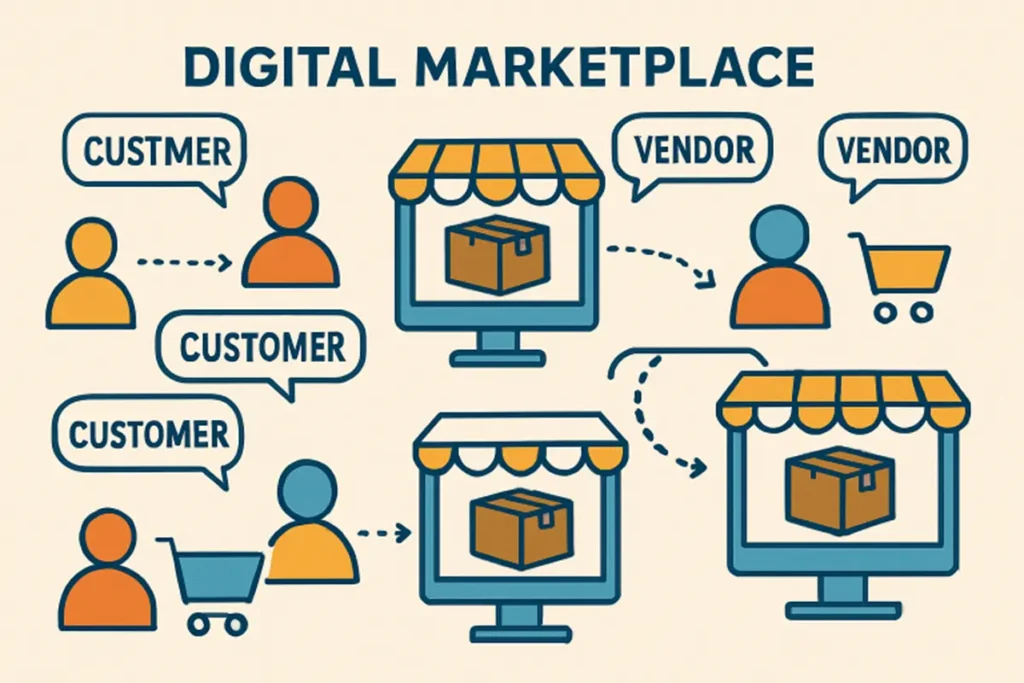Key Takeaways
- Online marketplaces account for over 60% of global e-commerce sales, with third-party sales driving significant growth.
- Discount-focused platforms like Temu and Shein are gaining popularity among cost-conscious consumers.
- Investments in logistics and fulfillment are enhancing customer satisfaction through faster deliveries.
- Marketplaces are diversifying into sectors like financial services and advertising to ensure long-term success.
- Compliance with local regulations and a focus on sustainability are becoming critical for marketplace operations.
Table of Contents
- Dominance of Online Marketplaces
- Rise of Discount-Focused Platforms
- Enhancing Logistics and Fulfillment
- Diversification into Adjacent Sectors
- Compliance and Sustainability
- Conclusion
Online marketplaces have become the backbone of digital commerce in recent years, fundamentally transforming the way goods and services are bought and sold globally. Their role continues to evolve, dynamically adapting to keep pace with shifting consumer preferences, regulatory changes, and technological advancements. As more businesses look to capitalize on this booming sector, Front Row does marketplace management, providing expertise and tailored strategies to help brands navigate this evolving landscape and maximize their presence on leading platforms.
The retail ecosystem, powered by these online marketplaces, now revolves around multivendor solutions where third-party sellers and millions of buyers meet in an intensely competitive environment. Innovative platforms are redefining customer expectations and amplifying competition. For brands and retailers, understanding these trends is crucial for sustainable growth in today’s marketplace-driven economy.
Dominance of Online Marketplaces
Online marketplaces accounted for 62% of global retail e-commerce sales, reaching USD 2.4 trillion, a figure expected to continue rising in the coming years. Their dominance is fueled by the remarkable surge in third-party (3P) transactions. In 2014, 3P sales represented just 72% of marketplace transactions. Still, by 2024, this figure had climbed to 81%. The growth of marketplace models reflects a significant evolution in retail strategy, one centered around collaboration, scalability, and adaptability to changing consumer behaviors. This shift enables these platforms to benefit from increased seller fees and advertising revenue, while maintaining lean and scalable operational structures.
Rise of Discount-Focused Platforms
Cost-consciousness among consumers has reached an all-time high, fueled by inflation and ongoing global economic uncertainty. Discount-focused online platforms have seen a significant surge in popularity among budget-conscious shoppers seeking maximum value for their money.
For many global consumers, ultra-low prices now outweigh considerations such as shipping times or brand prestige. This generational shift in shopping behavior is prompting even long-established online marketplaces to strengthen or introduce budget-focused sections within their platforms. The growing emphasis on affordability is intensifying competition across the entire e-commerce landscape, reshaping how retailers attract and retain cost-driven consumers.
Enhancing Logistics and Fulfillment
Online marketplaces accounted for 62% of global retail e-commerce sales, reaching USD 2.4 trillion, a figure expected to continue rising in the coming years. Their dominance is fueled by the remarkable surge in third-party (3P) transactions. In 2014, 3P sales represented just 72% of marketplace transactions, but by 2024, this figure had climbed to 81%. As discussed in Forbes, the growth of marketplace models reflects a significant evolution in retail strategy, one centered around collaboration, scalability, and adaptability to changing consumer behaviors. This shift enables these platforms to benefit from increased seller fees and advertising revenue, while maintaining lean and scalable operational structures.
Diversification into Adjacent Sectors
As platform competition intensifies, marketplaces are branching into new verticals to secure future growth and maintain customer stickiness. Financial services, retail media, value-added advertising, fintech integrations, and loyalty programs are among the most promising new frontiers. Grocery e-commerce is also gaining steam, with online marketplaces now processing nearly half (49%) of all fast-moving consumer goods (FMCG) sales worldwide in 2024.
Creating Seamless Ecosystems
Innovators like Amazon are blending once-separate platforms—such as Amazon.com, AmazonFresh, and Whole Foods—into unified experiences, aiming to compete head-to-head with legacy retailers like Walmart. These moves enable customers to transition effortlessly across product categories, increasing average order value and loyalty rates.
Compliance and Sustainability
New regulations are radically altering marketplace operations to protect consumers and encourage fair competition. The EU Digital Services Act requires the rapid removal of illegal products and strict seller verification, while updated VAT rules target low-cost cross-border parcels. In the US, the crackdown on “de minimis” imports poses a threat to platforms built on the cross-border, discounted model.
Transparency, compliance, and product authenticity are fast becoming non-negotiables for marketplaces aspiring to scale. Alongside regulatory pressures, sustainability is also gaining traction—green supply chains and ethical sourcing policies are now integral to platform reputations and ongoing success. Leading platforms communicate these values clearly to build consumer trust, respond proactively to legal demands, and future-proof their business models.
Conclusion
The era of online marketplaces defines the future of digital commerce, with innovation, efficiency, and a relentless customer focus driving their expansion. As platforms continue to embrace technology, streamline logistics, diversify into new sectors, and adhere to evolving regulations, their path to disruption and dominance looks secure for years to come.
Also Read-
- Tech Console DefStartup: Empowering Gaming Innovation
- Quick, Stress-Free Home Selling Tips
- Rethinking Your Exterior: Creative Siding Solutions for a Modern Home


